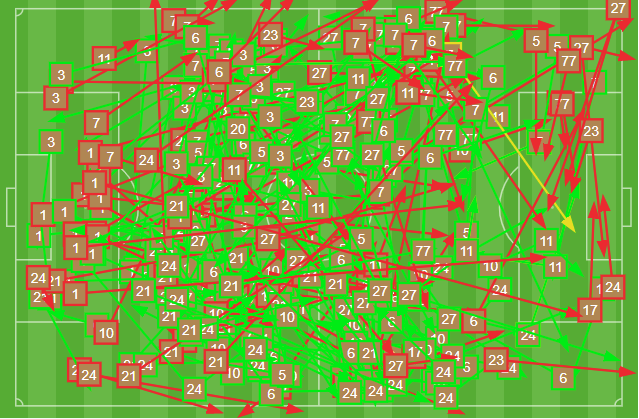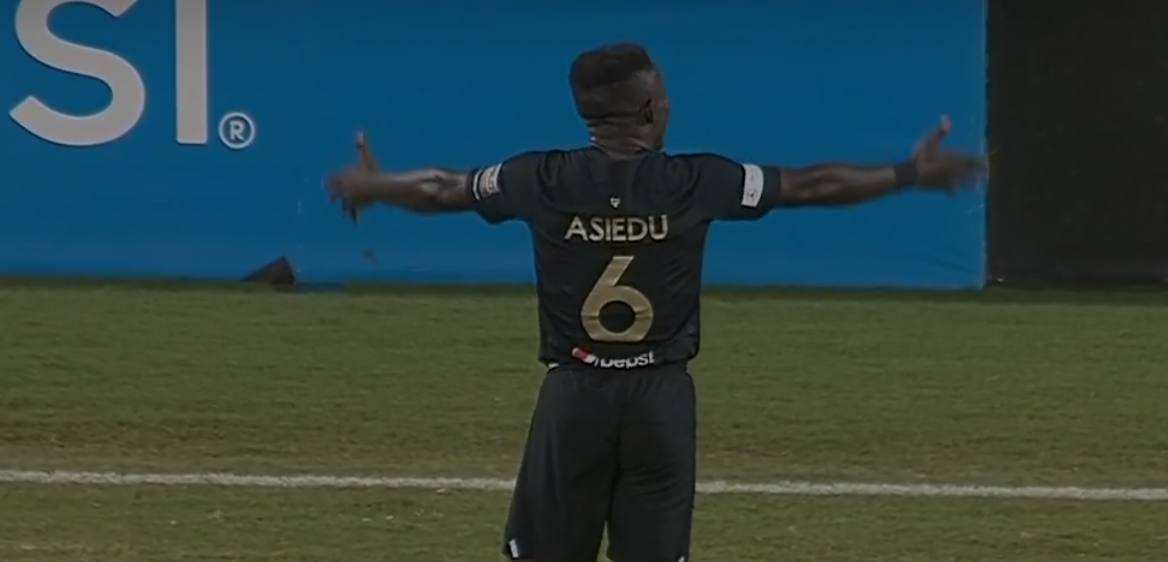As Mark Twain[efn_note]Quoting Benjamin Disraeli, or Arthur Balfour, or Walter Bagehot, or any one of about a dozen British wits[/efn_note] famously stated, there are lies, damned lies and statistics. None is more so than the modern possession stat in soccer. Most people imagine that there is some poor intern at every game nervously clicking away at a stopwatch as if he were playing an invisible game of chess. Once upon a time – and indeed in some locations till today – that is indeed what happens. However, organizations such as Opta have realized that is much simpler, and – probably more to the point – much cheaper, to allow a computer to do a basic mathematical calculation.
And what is that calculation, you ask? Well, it’s simply this: possession is the percentage of total passes attempted in the game by each side. It makes no adjustment for the amount of time a team holds the ball in between passes, or, for that matter, how long the ball takes while traveling between players. In most cases, this makes for a fairly reasonable approximation, since soccer is at its core a quick and short passing game.
Last Saturday, it demonstrated its shortcomings in a fairly dramatic manner. Anyone who watched the game and was later told that the Legion had just 40% possession would probably choke on their celebratory beer. There is no way that Birmingham was outplayed to the order of 50%. Did they have less of the ball? Almost certainly, especially late in the game when they were basically playing prevent defense, but nowhere near that much of a tilt was in evidence.
First, consider this: dribbling, by its very nature, takes up time. And when you are protecting a lead and take the ball to the corner and sit on it, as much time as possible (although the Legion didn’t really do that). In this game, the Three Sparks had 18 recognized dribbles in the stat book. Lou City had just 7. Oddly, only one of those was by Ryan James, and Jonny Dean had none. Admitttedly, Dean takes the ball down the wing at the speed of light and thus can’t be measured, but even so. The most prodigious dribbler on the squad was – Junior Flemmings. Go figure.
Now take a look at Birmingham’s overall passing chart:

As you can see, there are a lot of long passes in that chart, both successful and unsuccessful. That includes a few balls from Matt van Oekel that made it all the way to Parker Siegfried at the other end. Those suck up time.
That being said, it is true that the purple dinosaurs (and I am trying oh so hard not to call them the Barneys) did attempt 50% more passes than the Legion. Worse, if you count just successful passes (since an unsuccessful pass is a loss of possession, after all, exactly like an interception in football), that actually widens the gap a bit to 62-38. And yet, the good guys were not dominated in any real fashion.
Here’s the other kicker: possession is not worth much if you don’t do anything with it. We’ve had a good bit of that from the Legion this season. In this case the tables were turned. Louisville and Birmingham both had 9 shots in the game – a fairly low total by both teams’ standards – and only 3 on frame. Of Lou City’s 9 attempts, 4 came after JJ Williams scored the go ahead goal (with his first touch and barely 30 seconds after coming on, no less). Birmingham didn’t try any after that. Louisville found themselves in the unusual situation of chasing the game. They could have been chasing it even earlier if Neco Brett’s first half attempt hadn’t been miraculously saved.
It’s as if they weren’t really trying until they got the wake up call. Before Neco did get the opening score in the 51st minute, Lou City had just 3 shots and only one on target. And one of those was a long range attempt by Cameron Lancaster from the center circle looking to catch MvO out of position. He missed. But it was an opportunistic shot that was in effect against the run of play, not because Louisville were playing well.
Still, the Legion’s xG for the game was just 1.00 and Louisville’s was 1.35, so for once the Three Sparks outperformed that stat (which you always want to do, of course).
In the end, the game came down to who wanted it more. And that’s not a measurable stat. Or…is it? Birmingham created 10 scoring chances to Louisville’s 7, and 2 big chances to just 1 (per FotMob). You could plainly see it in the way the team played. It was a very refreshing and very welcome change from the loss to FC Tulsa just 6 days before.
And so, as we tweeted out last Sunday, Louisville finds itself still holding the divisional lead, but much more precariously than before, and they are in a very vulnerable position. The squad had 4 key players out with injuries before the game, and Pat McMahon went down in this one. That’s not good in and of itself. But then you also need to consider the Louisville schedule. Their home record is an impressive 9-1-2. Their road record far less so at 3-3-2. And that also means that of the remaining 12 games, 8 are on the road. 10 of the last 12 are against divisional opponents, all of whom will be out for blood. Everyone else in the Central Division has at worst an even home-road split in the final stretch; Memphis 901 has a whopping 10 home games left.
So, to quote another well-known purveyor of witticisms, it ain’t over till it’s over.





